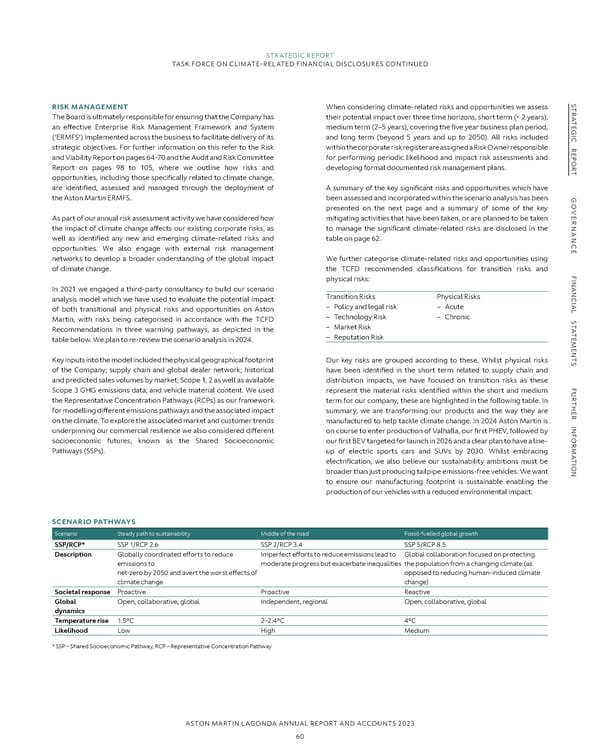STRATEGIC REPORT TASK FORCE ON CLIMATE-RELATED FINANCIAL DISCLOSURES CONTINUED S RISK MANAGEMENT When considering climate-related risks and opportunities we assess TR The Board is ultimately responsible for ensuring that the Company has their potential impact over three time horizons, short term (< 2 years), A TE an effective Enterprise Risk Management Framework and System medium term (2–5 years), covering the five year business plan period, G I (‘ERMFS’) implemented across the business to facilitate delivery of its and long term (beyond 5 years and up to 2050). All risks included C strategic objectives. For further information on this refer to the Risk within the corporate risk register are assigned a Risk Owner responsible R E and Viability Report on pages 64-70 and the Audit and Risk Committee for performing periodic likelihood and impact risk assessments and P O Report on pages 98 to 105, where we outline how risks and developing formal documented risk management plans. R T opportunities, including those specifically related to climate change, are identified, assessed and managed through the deployment of A summary of the key significant risks and opportunities which have the Aston Martin ERMFS. been assessed and incorporated within the scenario analysis has been G O As part of our annual risk assessment activity we have considered how presented on the next page and a summary of some of the key VE mitigating activities that have been taken, or are planned to be taken R the impact of climate change affects our existing corporate risks, as to manage the significant climate-related risks are disclosed in the NAN well as identified any new and emerging climate-related risks and table on page 62. C opportunities. We also engage with external risk management E networks to develop a broader understanding of the global impact We further categorise climate-related risks and opportunities using of climate change. the TCFD recommended classifications for transition risks and F physical risks: I In 2021 we engaged a third-party consultancy to build our scenario NAN analysis model which we have used to evaluate the potential impact Transition Risks Physical Risks C of both transitional and physical risks and opportunities on Aston – Policy and legal risk – Acute IAL Martin, with risks being categorised in accordance with the TCFD – Technology Risk – Chronic S T Recommendations in three warming pathways, as depicted in the – Market Risk A T table below. We plan to re-review the scenario analysis in 2024. – Reputation Risk E M E N Key inputs into the model included the physical geographical footprint Our key risks are grouped according to these. Whilst physical risks T S of the Company; supply chain and global dealer network; historical have been identified in the short term related to supply chain and and predicted sales volumes by market; Scope 1, 2 as well as available distribution impacts, we have focused on transition risks as these F Scope 3 GHG emissions data; and vehicle material content. We used represent the material risks identified within the short and medium U R the Representative Concentration Pathways (RCPs) as our framework term for our company, these are highlighted in the following table. In T H for modelling different emissions pathways and the associated impact summary, we are transforming our products and the way they are E R on the climate. To explore the associated market and customer trends manufactured to help tackle climate change. In 2024 Aston Martin is INF underpinning our commercial resilience we also considered different on course to enter production of Valhalla, our first PHEV, followed by socioeconomic futures, known as the Shared Socioeconomic our first BEV targeted for launch in 2026 and a clear plan to have a line- OR Pathways (SSPs). up of electric sports cars and SUVs by 2030. Whilst embracing M A electrification, we also believe our sustainability ambitions must be T I broader than just producing tailpipe emissions-free vehicles. We want ON to ensure our manufacturing footprint is sustainable enabling the production of our vehicles with a reduced environmental impact. SCENARIO PATHWAYS Scenario Steady path to sustainability Middle of the road Fossil-fuelled global growth SSP/RCP* SSP 1/RCP 2.6 SSP 2/RCP 3.4 SSP 5/RCP 8.5 Description Globally coordinated efforts to reduce Imperfect efforts to reduce emissions lead to Global collaboration focused on protecting emissions to moderate progress but exacerbate inequalities the population from a changing climate (as net-zero by 2050 and avert the worst effects of opposed to reducing human-induced climate climate change change) Societal response Proactive Proactive Reactive Global Open, collaborative, global Independent, regional Open, collaborative, global dynamics Temperature rise 1.5°C 2–2.4°C 4°C Likelihood Low High Medium * SSP – Shared Socioeconomic Pathway, RCP – Representative Concentration Pathway ASTON MARTIN LAGONDA ANNUAL REPORT AND ACCOUNTS 2023 60
 Annual Report and Accounts Page 61 Page 63
Annual Report and Accounts Page 61 Page 63